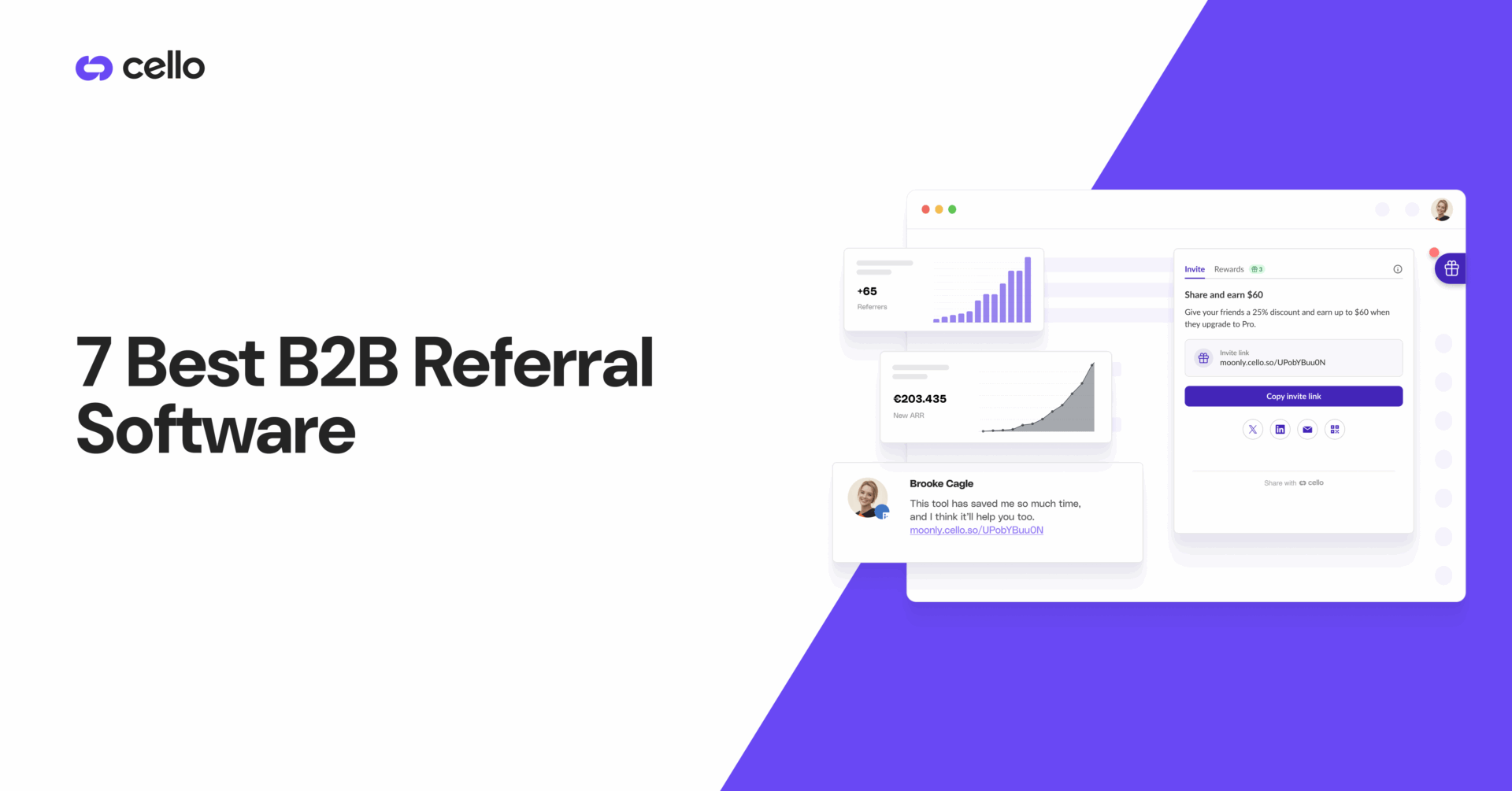
- Blog•
- 19 min read
Best B2B Referral Software for SaaS (2025): Features, Pricing & Picks
7 best B2B referral platforms for SaaS in 2025. See quick picks, pricing, and use-cases
- TL;DR Recommendations by scenario
- Which referral software should I choose?
- 1. Cello - Best All-in-One User and Affiliate Referrals for B2B SaaS
- 2. Impact.com Advocate (SaaSquatch)
- 3. PartnerStack
- 4. Rewardful
- 5. FirstPromoter
- 6. Reditus
- 7. Tapfiliate
- Comparison Table of the 7 Best Referral Software
- Which referral software should I choose?
TL;DR Recommendations by scenario
- Best overall: Cello - success-based pricing; in-product SDK.
- Best affiliate-leaning: PartnerStack - marketplace + multi-program.
| Scenario | Why Cello wins (concrete proof-points) |
|---|---|
| Early-stage SaaS (ARR < $10 M) | Zero cash risk: free tier until $5k referral ARR. < 1-day launch: copy-paste JS or mobile SDK Founder-friendly analytics: see revenue and pay-outs in one dashboard. |
| Growing / mid-market SaaS | Cost stays predictable: success-based billing—no seat or click fees. No hidden “pro” upgrade, all integration available. Built-in analytics and AI-optimization. |
| Global enterprise / regulated industries | GDPR + CCPA ready. Full localisation: UI strings & reward emails translate into 6 languages out-of-box (more on request). Proven at scale: Miro, Typeform, tl;dv trust Cello for millions of users. |
| Need referral UX inside your app | In-product SDK: web, iOS, Android & React-Native components that inherit your design tokens. Custom notification journeys: trigger emails, in-app toasts, or Slack when milestones hit. Mobile deep-linking & share-sheet support: track installs end-to-end. |
Which referral software should I choose?
In the world of referral marketing, choosing the right referral software can make a significant impact on your business growth. Brands like Dropbox achieved a staggering 3,900% growth in just 15 months through their referral program, while Mainstreet exceeded $3 million in revenue within six months using the right referral solutions. Moreover, buyers referred by friends are 18% more likely to remain loyal customers and generate more revenue (HBR).
Implementing the right referral program software enables you to automate acquisition efforts, track performance, and measure referral ROI with precision. For instance, some businesses like Smoobu have added more than 10% additional revenue by running successful referral campaigns with Cello, showcasing the power of effective referral tools.
This comprehensive guide examines the best B2B referral software for 2025, comparing their features, pricing, and ideal use cases to help you select the perfect solution for your business needs. We'll explore how these platforms can enhance your customer experience, boost customer retention, and ultimately increase customer lifetime value.
1. Cello - Best All-in-One User and Affiliate Referrals for B2B SaaS
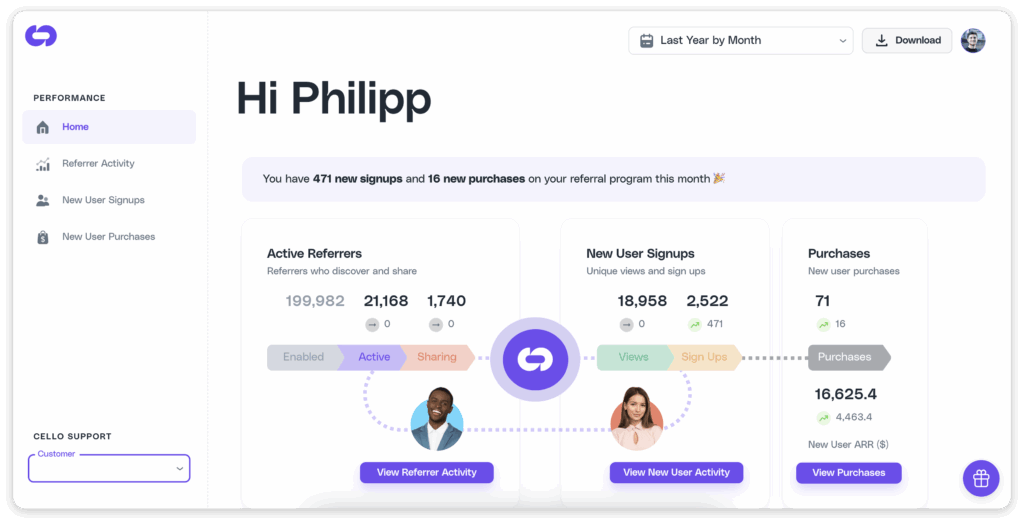
Positioned as the premier solution for B2B SaaS companies, Cello transforms your users into powerful growth engines through automated referral programs. Unlike traditional referral platforms, Cello stands out by enabling both user and affiliate programs within a single streamlined platform, enhancing the overall customer journey. The pricing includes both the user and affiliate referral products, which makes Cello the ideal solution for SaaS companies looking to streamline both their user and affiliate referrals in one software.
Cello key features
Cello's standout attribute is its frictionless integration that requires minimal development time—typically just a few hours. Cello offers:
- Seamless product integration – Embed referral components directly into your product with just a few lines of code, making sharing discoverable and accessible
- Automated rewards system – Direct integration with payment providers like Stripe enables automated attribution and success-based payouts
- Flexible referral options – Multiple sharing channels (email, social media, mobile) with auto-generated landing pages to maximize sharing potential
- Real-time performance tracking – Comprehensive analytics tools for monitoring program effectiveness and making data-driven decisions
- Enterprise-ready security – GDPR and CCPA compliant with automated fraud detection and seamless tax compliance
The platform supports localization in 12 languages (English, German, Spanish, French, Dutch, Italian, Portuguese, Danish, Slovak, Japanese, Norwegian, and Hindi) with the ability to add more on request. Furthermore, Cello's SDK supports both web and mobile implementations, including native integration for Android, iOS, and React Native.
Cello pros and cons
Pros:
- Zero development overhead with minimal setup time
- Success-based Freemium pricing with no hidden fees
- Tax and KYC compliant solution
- Fully automated attribution and success-based reward payouts
- Comprehensive real-time performance tracking tools
- Multi-language support and international reward capabilities
Cons:
- Might not be the best option if looking for a sophisticated Partner Management Portal
Cello pricing
Cello employs a success-based pricing model where you only pay when your program generates revenue. The platform offers four distinct tiers:
| Plan | Monthly Cost | Referral ARR Limit | Features |
|---|---|---|---|
| Free | $0 | Up to $5,000 | Unlimited referrals, All features & integrations, Both User & Affiliate Referrals incl. in the price |
| Grow | $250 | Up to $50,000 | Unlimited referrals, All features & integrations, Both User & Affiliate Referrals incl. in the price |
| Scale | $750 | Up to $100,000 | Unlimited referrals, All features & integrations, Both User & Affiliate Referrals incl. in the price |
| Enterprise | Custom | Unlimited | Unlimited referrals, All features & integrations, Both User & Affiliate Referrals incl. in the price |
Notably, there are no hidden costs for setup, currency conversion, or payment transactions, making it an attractive option for businesses looking to implement B2B referrals.
Cello best for
Cello is particularly well-suited for SaaS companies seeking explosive growth through user-led strategies. The platform excels for businesses that:
- Need quick implementation with minimal development resources
- Want to offer both user and affiliate referral programs from a single platform
- Require automated reward systems with international capabilities
- Prioritize security and compliance in their growth strategy
- Have product-led growth models where user engagement is critical
Companies like Miro, Typeform, VEED, and Pleo have successfully implemented Cello to drive significant referral-based growth. Consequently, Cello serves as an ideal solution for B2B SaaS companies looking to harness the power of word-of-mouth marketing through a sophisticated yet user-friendly referral platform.
Some customers like Smoobu have generated more than 10% additional revenue growth by implementing a referral program with Cello. Check out their customer success story here.
What customers say about Cello:
"Super fast and easy to set it up. Really straightforward to access data and insights, and implemement changes to improve the metrics. Also super helpful, kind, and experienced team. A real joy to work with them." - Raphael Allstadt, Co-Founder & CEO of tl;dv
"We had a frictionless setup and are seeing promising results. Cello efficiently and quickly helped us set up and experiment upon an important growth loop" - Linus Hallberg, Sr. Product Manager at Typeform

Why it stands out
Impact.com folded the SaaSquatch referral engine into its broader partnership cloud in 2023, so the Advocate module now sits beside affiliate, influencer and reseller tooling. Brands get one contract, one dashboard and a mature API layer for piping referral data into CRM, BI and finance systems.
That breadth is powerful—but because most flows are exposed as REST calls, you should expect a heavier engineering lift (Impact’s own docs recommend a “skilled web developer” to wire up server-side events).
Impact.com Advocate key features
- API-first orchestration – webhooks & open endpoints let you trigger rewards from any event (purchase, MQL, subscription upgrade, etc.).
- Single partner ledger – referral and affiliate payouts share funding, compliance and fraud-screening rails.
- White-label widgets & links – embeddable share links, advocate portals and themeable emails.
- Global infrastructure – Impact’s core platform runs 99.99 % uptime SLAs and enterprise-grade security.
Pros and cons at a glance
| ✅ Where it shines | ⚠️ Where teams struggle |
|---|---|
| Lives inside the same console as your affiliate & influencer channels—no data silos. | Ramp-up time: customer interviews put a typical rollout at 2–3 months once dev work starts. |
| Robust API + webhook model lets product teams stitch referral logic anywhere. | Cost model ties pricing to monthly licence plus API-call volume, which can spike as your program scales. |
| Enterprise compliance (GDPR, SOC2) and fraud-screening baked in. | No off-the-shelf advocate-notification journeys, so marketers must build these in their ESP—many see double-digit conversion drops until they do. |
| Multi-currency cash, card and store-credit payouts via Impact wallet. | Tax paperwork supported only for U.S. recipients; you’ll handle other regions yourself. |
| Consolidated analytics across all partner types. | Funnel reporting stops at a high level—no step-by-step breakdown of share → click → signup → closed-won. |
Pricing
Impact keeps exact figures behind sales quotes, but the standard deal pairs a monthly platform licence with a metered allotment of API calls. Additional overage and payment-processing fees are settled automatically from your funding account each month. (Source: Impact pricing page)
Best for
Not ideal for lean SaaS teams chasing a fast, no-code launch, or for companies that need per-step analytics and built-in communications out of the box.
Global enterprise brands that already use Impact for affiliate or influencer partnerships and are ready to invest significant in-house developer resources to implement referrals.
3. PartnerStack
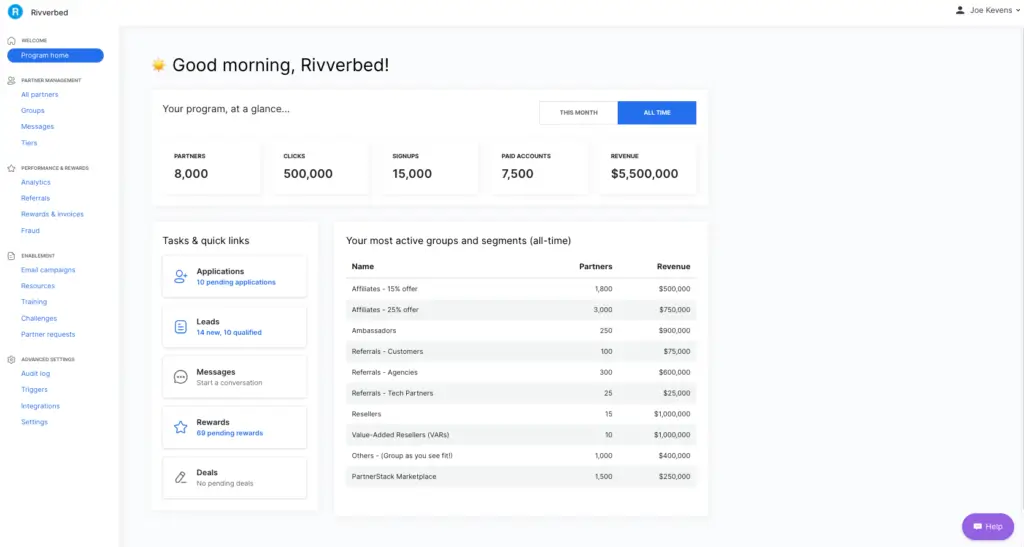
Why it stands out
PartnerStack was one of the first PRMs built specifically for B2B SaaS, so the platform lets you run affiliate, referral and reseller programs side-by-side and pay all partners from one wallet. Its network of ~300 listed programs and 100 k+ registered partners can give new vendors a running start, and the UI layers on lightweight gamification—“challenges”, tier badges, etc.—to keep partners engaged.
PartnerStack key features
- Multi-program engine – spin up affiliate, customer-referral or co-sell motions in “groups” under the same account.
- Partner Marketplace – public directory where 65 k+ partners browse programs.
- Embeddable referral widget – generate share links inside your product without forcing users to create partner accounts.
- Report builder & webhooks – surface clicks, sign-ups and revenue by partner, then push events to your CRM or data warehouse.
Pros and cons at a glance
| ✅ Where it shines | ⚠️ Where teams struggle |
|---|---|
| Runs affiliate, referral and reseller programs in one console—useful for growing SaaS ecosystems. | Ramp-up time: PartnerStack cites a 74-day average implementation, which is much higher than comparable benchmarks. |
| Built-in marketplace can seed early partner recruitment. | Marketplace depth skews toward affiliate publishers; vendors selling via pure customer referrals say listings generate limited deal flow. |
| Automated payouts, W-8/W-9 collection and 1st-party tracking reduce compliance headaches. | Ongoing admin load: reviewers note that once live, partner approvals, link management and challenge setup still demand weekly attention. |
| Flexible program “groups” let you test incentives without cloning your whole account. | Entry-level cost is higher than freemium rivals; several SMBs call pricing “expensive for getting started.” |
| Native widgets and APIs cover most partner journeys without heavy custom code. | Focus of product roadmap leans toward affiliate use-cases, so referral-only teams sometimes feel secondary. |
Pricing
PartnerStack offers quote-based contracts. Expect a platform licence plus transaction fees, with higher tiers unlocking marketplace boosts, advanced reporting and API volume. Because no public free plan exists, early-stage SaaS teams often run a cost–benefit check against lighter “pay-as-you-grow” tools before signing. (Source: PartnerStack pricing page)
Best for
SaaS companies with multi-channel partner strategies (affiliate + reseller + referral) that want everything under one roof and have a partner-marketing and developer headcount to keep the program humming. Brands that have significant budgets and time to implement PartnerStack (74 days implementation time cited on PartnerStack's website)
Less suited to startups seeking a low-code, high-performing user referral solution or brands that need out-of-the-box customer-referral journeys with minimal configuration. Softr, a no-code app builder, for example, increased their Free-to-paid Conversion rate 7.5x (1.3% to 9.7%) by switching from PartnerStack to Cello for their referral program.
4. Rewardful
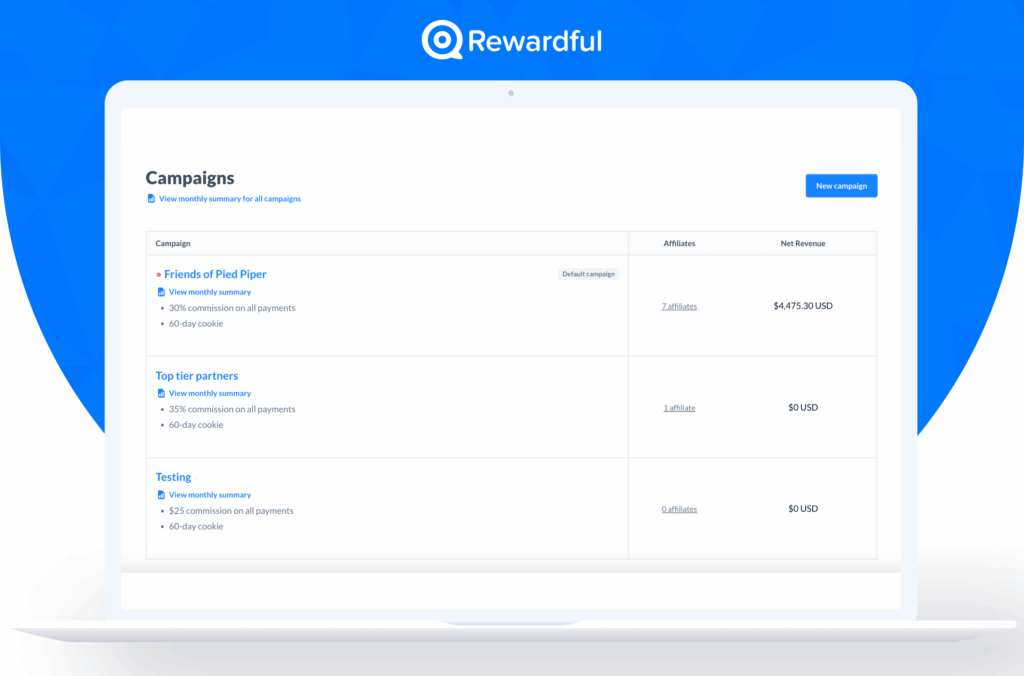
Why it stands out
Rewardful markets itself as the “two-scripts and done” way to bolt referrals onto a SaaS product: copy a JS snippet, connect your Stripe (or Paddle) account, and start issuing links in about 15 minutes. The product ships a native two-way Stripe sync, PayPal/Wise bulk-payout hooks, and an “Affiliate Finder” crawler that digs for potential promoters on the open web.
Rewardful key features
- Two-way Stripe sync – conversions and refunds flow straight into your Stripe dashboard.
- Affiliate Finder search tool – crawl the web for niche partners instead of waiting for a marketplace request.
- REST API & webhooks – push events into Zapier or a data warehouse.
- 0 % transaction fees on every plan (revenue caps apply).
Pros and cons at a glance
| ✅ Where it shines | ⚠️ Where teams struggle |
|---|---|
| Setup is genuinely fast—docs say ~15 minutes, no engineer needed. | Manual or CSV payouts: users still have to push payments themselves; “no managed payout system yet.” |
| Deep Stripe integration keeps billing and attribution in one place. | Payment-related headaches are the #1 complaint theme on G2 (17 mentions). |
| Built-in Affiliate Finder removes dependence on crowded public marketplaces. | Limited analytics & feature gaps—advanced reports sit behind higher tiers and still miss step-level funnels. |
| 0 % fee structure looks inexpensive on paper. | Reviewers call the $49–$99 entry point “steep for what it does,” especially when you need to pay $100+ to unlock meaningful tests. |
| Simple portal widgets work for one-product SaaS apps. | Works only with Stripe or Paddle; other gateways are unsupported. |
| Customisation and webhook reliability need tinkering—some devs report missing events or signature mismatches. |
Pricing
Rewardful uses a revenue-cap model:
- Starter $49/mo – up to $7.5 k affiliate revenue.
- Growth $99/mo – doubles the cap to $15 k and unlocks unlimited campaigns + branded portal.
- Enterprise $149+/mo – higher caps and a named CSM.
(Source: Rewardful pricing page)
Best for
Solo founders and early-stage SaaS teams who live 100 % inside Stripe and need a lightweight affiliate layer today.
Less suited to scale-ups and global enterprises that need automated payouts, granular funnel analytics, or payment processors beyond Stripe/Paddle.

Why it stands out
FirstPromoter grew up beside the indie-SaaS wave and keeps the footprint small: drop a JS tag, link Stripe or Chargebee and your affiliates start earning within a few clicks. The app handles recurring-revenue tracking out of the box and can trigger PayPal / Wise payouts from the dashboard.
That simplicity is appealing—until you need deeper automation or analytics.
FirstPromoter key features
- Direct Stripe / Chargebee web-hooks for automatic commission adjustments on upgrades, downgrades and refunds.
- Bulk PayPal & Wise payouts (CSV upload or API) plus optional tax-form collection in the promoter portal.
- 18-metric reports covering clicks, MRR and churn-adjusted net revenue.
- REST + Webhooks API to pipe events into Zapier or your data warehouse.
- Simple promoter dashboard with link generator, resources tab and coupon support.
Pros and cons at a glance
| ✅ Where it shines | ⚠️ Where teams struggle |
|---|---|
| Light footprint—most devs wire Stripe in an afternoon. | Onboarding feels too complex for non-technical teams; many lean on support to finish setup. |
| Recurring-revenue tracking works well for subscription SaaS. | No built-in marketplace to discover new affiliates, so growth depends on your own recruitment. |
| PayPal / Wise bulk payouts cut monthly finance drudgery. | Missing bulk actions in the UI; approving or editing promoters one-by-one is common. |
| Friendly support team regularly called out in reviews. | Reporting quirks—users cite mismatched numbers and credit leakage between campaigns. |
| Clean API lets you export raw events. | Limited customisation & aging UI; several reviewers want fresher design and brand-matching pages. |
| 0 % transaction fees keep variable costs low. | Entry tier starts at $49 / mo and climbs quickly once affiliate revenue passes $5 k, prompting price-sensitive teams to look elsewhere. |
Pricing
| Plan | Revenue Cap (from affiliates) | Monthly cost* |
|---|---|---|
| Starter | up to $5 k per month | $49 |
| Business | up to $15 k per month | $99 |
| Enterprise | custom | $149 + |
*Exceed the cap and you auto-upgrade to the next tier.
Best for
Bootstrapped SaaS founders whose stack revolves around Stripe and who can live with lightweight analytics.
Less suited to teams that need bulk admin tools, partner marketplaces, or more complex reporting.
6. Reditus
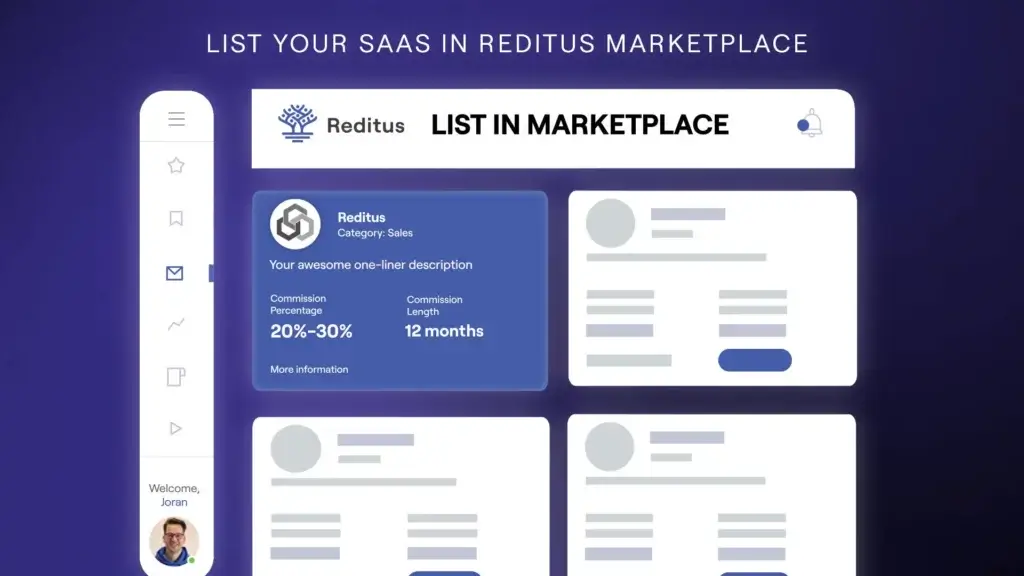
Why it stands out
Reditus positions itself as a “B2B SaaS-only affiliate network”: connect Stripe or Paddle, drop a snippet, and list your program in front of ~15 000 pre-vetted SaaS-centric affiliates.
Reditus key features
- SaaS-only marketplace – your offer appears in a directory promoted to 15 000+ affiliates once you’re on a paid plan.
- Stripe / Paddle tracking – native hooks bring in recurring revenue and refund events so commissions stay accurate.
- Recruit & tier tools – invite links, auto-accept rules and multi-tier payouts come out of the box.
- Automated payouts (Scale Up only) – Reditus will charge your card and pay affiliates on your behalf, for an extra fee. Lower tiers export a CSV and do manual payouts
Pros and cons at a glance
| ✅ Where it shines | ⚠️ Where teams struggle |
|---|---|
| Built-in marketplace jump-starts partner recruitment without cold outreach. | Payment friction tops user complaints: delayed commissions, PayPal-only withdrawals and manual CSV uploads. |
| Quick Stripe/Paddle install gets a program live fast. | Automated payouts gated behind the highest-priced tier; most users still run monthly payout batches by hand. |
| Flat, 0 % transaction fees make costs predictable. | MRR caps are low—hit $5 k or $10 k in affiliate MRR and you’re forced to upgrade. |
| SaaS-specific metrics (MRR, churn) in the dashboard. | Reviewers mention limited funnel detail and “missing pieces” in reports. |
| Helpful knowledge-base and onboarding video. | Communication lags with support and application approvals show up in reviews. |
Pricing
| Plan | Affiliate-generated MRR cap | Key limits |
|---|---|---|
| Startup (Free) | $5 k | No marketplace listing, manual payouts |
| Growth ($299 / mo) | $10 k | Marketplace access, still manual payouts |
| Scale Up ($499 / mo) | $20 k | Automated payouts, recruitment feature, Slack support |
Exceed the cap and Reditus upgrades you automatically to the next tier.
Best for
Early-stage B2B SaaS teams that live inside Stripe/Paddle, want a ready-made affiliate directory, and don’t mind doing manual PayPal payouts themselves.
Less suited to companies that:
- need multi-currency payout options or ACH/wire
- require deep attribution & step-level analytics
- expect affiliate MRR to eclipse $10 k quickly
7. Tapfiliate
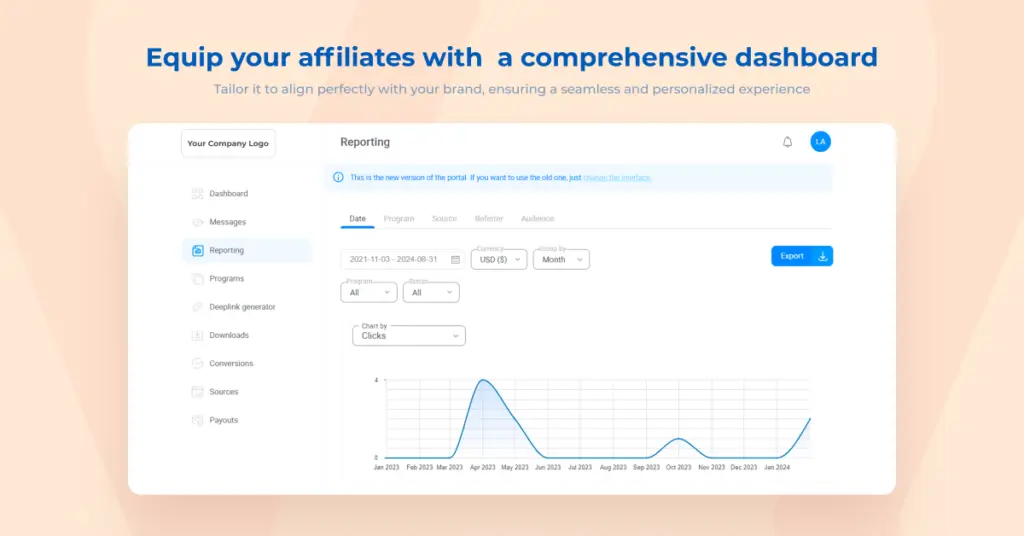
Why it stands out
Tapfiliate pitches itself as a “drop-in” affiliate & referral tracker for SaaS, e-commerce and subscription apps: paste a JS snippet, connect Stripe/Shopify/Paddle, and start logging clicks within minutes. Thirty-plus pre-built integrations, white-label options and 0 % transaction fees keep the learning curve gentle.
That convenience is real—yet users who grow past the basics often discover limits hiding behind upgrade walls and browser-privacy caveats.
Tapfiliate key features
- JS, REST & S2S tracking – choose pixels or post-backs; recurring-revenue events sync from Stripe or Chargebee.
- White-label & custom domains – remove Tapfiliate branding and host the portal on your own URL (Pro+).
- 30 + one-click integrations – Shopify, WordPress, Recurly, Zapier and more.
- In-app messenger & bonus engine – nudge affiliates and run performance-based incentives (higher tiers).
- First-party cookie attribution – 45-day default window; optional S2S for stricter privacy setups.
Pros and cons at a glance
| ✅ Where it shines | ⚠️ Where teams struggle |
|---|---|
| Five-minute embed with Stripe/Shopify; no engineer needed for a basic launch. | Deceptive value curve: reviewers say core features feel “very limited unless you upgrade,” and the price jump surprises many. |
| No transaction fees; predictable monthly licence. | Clicks can disappear if visitors use ad-blockers or land/convert on different domains—Tapfiliate’s own docs list these as “unsupported.” |
| White-label portal and custom domain on Pro plan. | Overage maths: 20 k clicks & 2 k conversions on Essential, with $1.50 / $15 per extra 1 k—costs scale quicker than expected for active programs. |
| In-platform messenger helps broadcast promos. | Users report slow support responses and sparse Stripe documentation, leading to DIY debugging. |
| Simple UI suits small affiliate rosters. | Cannot handle large partner counts or in-portal communication threads; scaling teams export to spreadsheets. |
Pricing (monthly, billed monthly)
| Plan | Clicks / Conversions cap | Core extras | Price |
|---|---|---|---|
| Essential | 20 k / 2 k | Real-time reports, email/chat support | $89 |
| Pro | 100 k / 10 k | Custom domain, MLM, bonus system | $149 |
| Enterprise | Unlimited | Full white-label, SSO, dedicated CSM | Custom |
Overage fees run $1.50 per 1,000 clicks and $15 per 1,000 conversions on Essential.
Best for
Bootstrapped SaaS or boutique e-commerce brands that value a fast Stripe embed and can keep affiliate traffic under 20 k clicks a month.
Less suited to scale-ups needing cross-domain tracking, deep funnel analytics, high-volume caps or rapid-fire support.
Comparison Table of the 7 Best Referral Software
| Rank | Platform | G2 | Starting Price | Best For | Key Watch-out |
|---|---|---|---|---|---|
| 1 | Cello | 4.9 | Free | SaaS brands needing in-product, success-based referrals | Might not be suitable if looking for complex PRM |
| 2 | Reditus | 4.8 | Free | Early-stage SaaS wanting a built-in affiliate marketplace | Manual PayPal payouts; low MRR caps force upgrades |
| 3 | PartnerStack | 4.7 | Quote | Multi-channel (affiliate + reseller + referral) ecosystems | ≈3-month rollout & higher licence cost than freemium tools |
| 4 | Impact Advocate | 4.5 | Quote | Enterprise brands already on Impact’s partnership cloud | Heavy dev lift; must custom-build UI and notification journeys |
| 5 | FirstPromoter | 4.5 | $49 | Stripe-centric SaaS after quick affiliate + referral tracking | Limited analytics, limited attribution infrastructure |
| 6 | Rewardful | 4.4 | $49 | Stripe/Paddle start-ups wanting a five-minute embed | No managed payout system—CSV or manual transfers only |
| 7 | Tapfiliate | 3.3 | $89 | Boutique e-commerce & SaaS needing white-label portals | Clicks can drop on cross-domain/ad-block; core features gated to higher tiers |
Which referral software should I choose?
Referral programs aren’t just another acquisition channel: they’re a compounding growth engine when they’re managed well. The data backs it up: Dropbox’s 3,900 percent surge, Mainstreet’s $3 million in six months, and Smoobu’s double-digit revenue lift all underline how powerful a single enthusiastic customer can be when the mechanics are friction-free and rewards are aligned to real value.
Among the platforms we analysed, Cello rises to the top for B2B SaaS teams thanks to its success-based pricing, in-product SDK, and hours-not-weeks implementation path. But the “best” choice still hinges on your specific context.
Whichever route you take, remember that technology is only half of the equation. Clear incentive design, seamless in-product discoverability, and ongoing optimisation of copy, rewards, and timing are what turn a referral engine from “good” to “Dropbox-level breakout.” Start small, measure early wins, and iterate. With the right platform and disciplined experimentation, you can convert your happiest customers into a scalable, cost-efficient sales force. Learn more about B2B referral marketing in our Complete Guide to B2B Referrals written in collaboration with Kyle Poyar.
What are the key features to look for in B2B referral software?
Important features include customizable referral program incentives, automated tracking and payout systems, API integration capabilities with existing tools, comprehensive analytics, and fraud prevention mechanisms. The best platforms integrate seamlessly and become a natural part of your product UX.
How can B2B referral software impact customer acquisition costs?
B2B referral software can significantly reduce customer acquisition costs by leveraging existing customer relationships. Referred customers often have higher conversion rates and lifetime values, leading to a more cost-effective acquisition strategy compared to traditional marketing campaigns.
Which industries benefit most from implementing B2B referral programs?
While B2B referral programs can benefit various industries, they are particularly effective for SaaS companies, where customer advocacy and word-of-mouth play crucial roles in growth.
What metrics should businesses track to measure the success of their referral program?
Key metrics to track include referral rate (percentage of customers participating), conversion rate of referred leads, customer acquisition cost for referred customers, lifetime value of referred customers, and overall program ROI. Additionally, tracking engagement metrics like share rates and click-through rates can help optimize the program over time. Monitoring Net Promoter Score can also provide insights into customer satisfaction and likelihood to refer.
